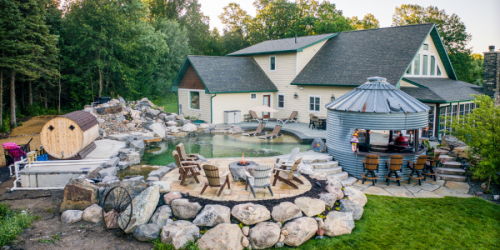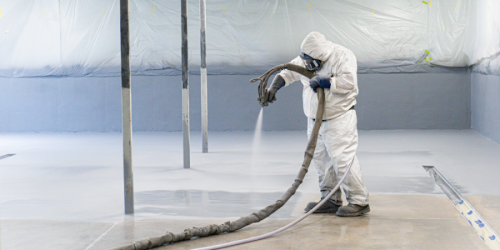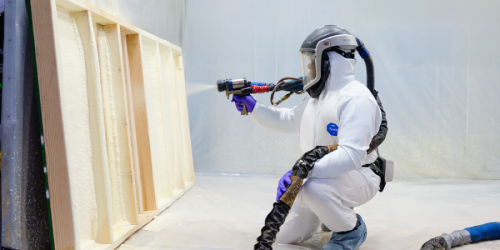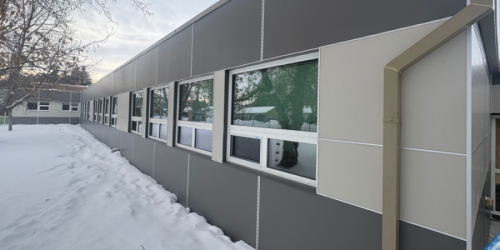Q&A Forums
Current Yields Post New Topic | Post Reply
| Author | Comments |
|---|---|
|
Melvin Chandler
Posted: Aug 01, 2006 09:56 PM
|
Current Yields
We are closing in our equipment arrival. Will be off for training in a few weeks and have spent the last few weeks marketing. Starting to receive calls about pricing and I'm wondering what the current yields on .5 lb and 2 lb are running???We were told by a rep that we should be selling 2" closed for about 1.65/sf in walls and 2" closed in ceilings for 1.90/sf. At 4000sf/set I'm getting a material cost of 1.10/sf applied which leaves little margin for labor. Is anyone spraying that cheap? What about base specs for closed? What is typical wall and ceiling thickness. I know the standard for open is 3.5 and 5.5". |
|
Ryan Rhoads
Posted: Aug 03, 2006 08:48 PM
|
I am not sure how you are figuring your material cost at $1.10. Take the cost of your material plus shipping, should be around or probably more likely under $2000 then divide that by 4000 B.F. I came up with about $.50. Also 4000 B.F. seams a little low to me but I figure 4500 BF and usually get a little more than that at 7500 ft. in elevation. And yes I am charging even less than that and finding it hard to make money by the time I pay insurance, labor, and phone bills. It just depends on what the compitition charges. Really we should be getting between $.90 and $1.00 per BF. Or higher if the market will bare it. Also why are ceiling higher? I charge the same for everything walls or ceilings. It would be a real extra pain for me to figure ceiling seperate as well, people already want me to give them three or four options on thickness. |
|
Melvin Chandler
Posted: Aug 03, 2006 10:28 PM
|
I'm figuring the mat as priced and using 4500sf with tax included. No profit or overhead. I'm at between 1.00 and 1.10 per sf at 2". I want to err high so I don't end up paying more than I estimated. I've yet to spray and want to calculate on the safe side. Should be spraying within a few weeks. Have everything but genset here and ready to go with some training to do. So lets go with your number and say our material cost for 2" is 1.00/sf. I understand you to say that you do charge less than 1.65/sf or .83/bdf. Doesn't that equate to .33+-/bdf net for labor? I think that .90/bdf sounds good but it's still a lot less margin than what closed is going for. Following up on one of the earlier threads, I think it's crazy to sell/install a premo product and make less margin than the lesser of the two products. I also think it's hard not to charge at least the amount of the product because the product value can't possibly be more than the experience, labor and equipment value to install it. As for why it's recommended to charge more for spraying an attic/roof deck; it should take more work and time to do so. If you are working a truss attic, there's obstacle everywhere to pull your hose around. Probably no flooring to stand on. Risk is higher working higher. Kind of like brick masons charging one price for installing on one buck and more for working on 3 bucks. I know there are times that you have to do what is necessary to get by but that can establish a mind set. Make the jakelegs come to your level of pricing. You can always go up. Don't ever go to the jakelegs level of pricing. There's too many good paying/good bene jobs out there to work for free. |
|
John Shockney
Posted: Aug 03, 2006 11:07 PM
|
Don't find out the hard way (like I did!) that yields can drop by 50% when spraying cold heat absorbing materials like concret block or poured walls. Thanks, Airpro |
|
Dave Strnad
Posted: Aug 04, 2006 07:44 AM
|
Yield is very important, that is why many of the supply companies play around with the blend to up the yield. My supplier claims between 5000-6000 bdft. I have got around 5500 bdft per set so far. I am pretty happy with that. As far as pricing, DO NOT LISTEN TO SUPPLIERS OR SALES REPS OR TRAINING SEMINARS. There is what it should be worth and there is what the actual market is, which can be dramitically different from one place to the next. Do the research find out what the local guys are getting for it. Locally closed cell is going for $.75 bdft when applied @ 2.5" in Walls and 4" in ceiling. Now when only 1" is applied then the price per bdft is higher between $1-$1.25 Bdft. Many varibles affect price and simply doing a bdft price is not the best way to bid. It gets you close but once you figure things out you will want to look at your expenses for the specific job. Unfortunatly $.30 bdft for labor seems pretty close. Now @ 8000 bdft for a small addition walls and ceiling and 1-2 days work depending on attic application. Thats still not bad, this is not some get rich quick business. It is hard work and frustrating at times and if you are going to make it, you have to consistantly get work, even though some of the sales reps make it out like all you need to do is one job a month. Ok I'm done ranting I had a big shock when I started bidding jobs and felt mislead. Also you need to remember that even though you have $80,000 invested there are guys out there with $10,000 or less in there setup and can spray just as good of product. |
|
Posted: Aug 05, 2006 05:53 AM
|
airpro... you may notice the decreased yield utilizing the spray foam materials as a "pour" type application... i have now poured four structures utilizing the plastic as an expansion barrier and yep...the yield was down,,cause the foam is denser cause it doesnt expand to it fullest extent... denser foam=higher rvalue... our prelimenary observations show that this process is slower in its rate of application, results in less yield,,,makes a nice side to side full cavity application,,,is easier on the applicator,,, it will have a place in our application armentum, but it will not replace the open cavity spray application.. |
|
Melvin Chandler
Posted: Aug 05, 2006 09:29 AM
|
Foamdude, What type of equipment are you using to spray/pour the foam? Is that basically injection foam? Is there an injection/pour tip for say a P2 or Fusion? Can you use the product with a 20/35Pro? Are you retro fitting walls or injecting block? |
|
Gerry Wagoner
Posted: Aug 06, 2006 04:17 PM
|
Spraying overhead costs more in several aspects. First, gravity is working directly against you. Second, it requires more overspray protection/removal. Third, it gums up the gun and the operator. Fourth, it takes more time. .90-1.00 per board foot is quite reasonable for rigid foam. gcw |
|
Gerry Wagoner
Posted: Aug 06, 2006 04:22 PM
|
What kind of foam are you using Dave? thanks, gcw |
|
Dave Strnad
Posted: Aug 06, 2006 08:41 PM
|
Probally shouldn't use names, but as long as its positive I will. I use NAP they are great to deal with and seem to have a good product. They are a little higher than some, but are somewhat local and have been the best people to talk to so far. They are around $2200 per set delivered. Yield is between 5-6000 bdft. Now on a seperate note as far as yield is concerned I know that there is more to it than this, but dosen't it seem like 2lb foam would = 6000bdft. 1000/2 = 500 X 12= 6000 bdft. Where does the rest go? or is the foam not really 2lb or 1.7 lb, etc. Anyway just a thought. |
|
Posted: Aug 06, 2006 09:17 PM
|
Newbee,,,using a Pro here,,,useing the fusion with an 04 (70-70) chamber...hanging the plastic,,cutting a vertical 3"slot at ~18 above bottom plate,,,stick nozzel thru slot..point at plate,, trigger while fanning side to side...hold expansion back with gloved hand,,,nudgeing it up and in...you will rapidly learn how long to trigger the gun....i tried a fan tip and it did not work well for me...way to little output...its a slower process already..next slot came at ~42" above bottom plate,,,and so on to the top plate... my vendor does not have a half pound pour foam so i am using spray wall foam...i peel the plastic down to trim the studs and any long bulges,,you do save time here for sure...but you dont save product,,,it is in the wall,,,but man is it easy on the applicator on a hot summer day... i pretty much stick with spray applied urethanes,,,i think about a masonry block fill setup every now and again,,,not sure i want to do retrofills,,... |
|
Posted: Aug 06, 2006 09:30 PM
|
dave,,, you may be right,,,5-6K would put you in the 1.5to 1.7 lb density,,but hey man,,,at $2200 for 5500 brd ft you are at $0.40 for fluids...this isnt a bad number in todays world for fluids... |
|
Gerry Wagoner
Posted: Aug 07, 2006 10:43 PM
|
Hi Dave. I been using some Nap too. Had good luck with it. 3100 to 6400 yield. The 3100 was 1" on concrete basement walls. gcw |
|
Dave Strnad
Posted: Aug 08, 2006 06:41 PM
|
Olger, what type of finish are you getting. It seems like the best texture I can get on the walls is + - 1/4" which makes for 1/2"difference from peak to valley when applied at 1 1/4" passes. I'm still new but have tried really hard to smooth it out a bit more with out much luck. So far I love the yield and customer service from nap. |
|
Gerry Wagoner
Posted: Aug 08, 2006 08:28 PM
|
That finish is acceptable. Few people indeed can spray foam in a studwall within .25". Undulations are the nature of the beast. gcw |
|
Gerry Wagoner
Posted: Aug 08, 2006 08:28 PM
|
That finish is acceptable. Few people indeed can spray foam in a studwall within .25". Undulations are the nature of the beast. gcw |
|
John Shockney
Posted: Aug 10, 2006 11:42 PM
|
foamdude I just finished a job using wall forms and yield was good and close to manufacture est. of 15k bdft. As long as you don't go too fast and over fill the cavity. The yield is less if you pack it in and yes when I hand form the foam I then pack it in so I don't have to trim and the yield goes way down. But my customers love the way the foam comes out and they get a full!! filled 2x6 wall. I have no problem colecting for any extra materal used, because it's all in the wall not on the floor or in the trash. Newby I'm using the GlasCraft P2 gun there is a pour adapter, fan spray adapter, and a jet adapter that they tell me will shoot foam 15 ft, I haven't tryed it yet. thanks Airpro |
|
Melvin Chandler
Posted: Aug 11, 2006 08:47 AM
|
So how do the wall forms work? Do you just put a form up on a stud wall and spray down in the cavity then pull the board rather than cut the excess? |
|
John Shockney
Posted: Aug 11, 2006 07:09 PM
|
Newby I first staple up 2mil clear plastic on the wall then I take white vinyl latice and screwed it in place with 1x3 furing strips. Using my P-2 with pour adapter and 3 inch long pices of 1/4 tubing poked holes through the plastic and inject 0.5# open cell foam. You then remove the latice and plastic, trim excess foam <<<check this link for a picture I'll get some more pictures posted Thanks Airpro |
|
Melvin Chandler
Posted: Aug 12, 2006 02:54 PM
|
Nice! But what is the advantage if you have to install the plastic and still trim? |
|
John Shockney
Posted: Aug 12, 2006 05:35 PM
|
The bigest advantage is little to no overspray so you don't have to wear all your heavy safty gear. I only wear a half mask with ov cartriges, safty glasses,long sleave shirt,and gloves. This is great on hot days. Also if you have a customer that wants full filled walls it cuts wast by 75% because you don't have to overfill the walls and trim 2-3inch thick pices off when your done. Thanks Airpro |
|
SprayFoamSupply.com
Posted: Aug 13, 2006 08:32 AM
|
Up here in NH I charge .85-.95 a bd ft, depending on the job for the closed cell foam. I base my material cost on 4500 bd ft yield using "R"tite 150 water blown closed cell foam. I figure the yield to be more like 5000 bd ft, especially in the summer, but you don't want to sell yourself short. I usually put 3.25" in the wall and 5" in the ceiling, sometimes the customers want more. I just finished a job that the homeowner wanted 12" in the ceiling and 6" in the walls! Newby, typical application thicknesses depends on building codes in your state. Even though people in the business are confident that 3" and 5" will outperform fiberglass, we still need to meet the required R-values. If R-38 is required in the ceilings in your area, you need to put 10" of open cell foam. No matter what you charge, the only way to make money is to have the trigger pulled. Whenever the machine is sitting, you are losing money! Make sure you cover everything that you want to keep, windows, doors, fireplaces, etc. You can spend an unbelievable amount of time cleaning foam off of things that should have been covered. I agree, you can't apply a premo product, that requires expensive equipment and a fair amount of knowledge for small margins. There is always alot of discussion about yield. So many things can affect it and most manufactures will massage the numbers so that their product looks better than others. The lighter the density, the greater the yield. The applicator also has alot to do with the yield. If you spray slowly and with each pass, you do not spray into rising foam, you get a better yield. When you spray into rising foam, you densify it, thus the yield goes down. If the substrate is warm, you get a better yield, cold and you pay. Dave, you are correct in thinking that a 2lb foam should yield 6,000 bd ft. That is how the math works out. Some of the blowing agent comes out during the application. The 2 skins on both sides of the foam are also very dense 20-40lb, so that has to be factored into the yield. By the time you spray a whole set, that is alot of skin. 2lb density foam is based on the core of the foam, not the skin. Having a lighter density will result in a little less smooth finish, but it is the way it is and is totally acceptable. I always inform the homeowners of this. Has anyone ever taken a piece of 245 foam and put it in the freezer and then cut it open? I am curious to see if there is enough gas in there to see liquid when it is frozen. If so, wouldn't that affect the performance when it is cold outside and the foam against the sheathing is below 59? George |
|
Dave Strnad
Posted: Aug 15, 2006 02:05 PM
|
George, You bring up a good point, it seems like it should liquify. I am not really for or against any particular product. After researching the options I felt the 245 products performed better. This whole industry has me frustrated. I am a sceintific person and want to know how and why something works or doesn't work. Suppliers and sales reps make claims that can not be backed up or are backed up without independent research. I will test to see if it does liquify, I am guessing that there is not enough to see with the naked eye. Not to start a debate, but how can water blown foam have an R-value higher than 3.5. Unless I am missing something it is the voids(bubbles of 245A or air in water blown) that make insulation. So if air has an r-value of 3.5 per inch how can a foam that uses air as an insulator acheive a higher r-vale. Like I said I'm not bashing an products, I'm just trying to understand the science behind it, I have many unanswered questions about the products out there. During my research I got a bad impression from a lot of the soybased water blown foams. The soybean association was giving grants of $35,000 to manufactures for every state in which they were distributers. Thats why many of the soy based products have dead websites, phone numbers, etc. they came and went and came back again under different names. Now I know that doesn't apply to them all and I will use biobased in the future. It was just one of the reasons I went with 245a products. |
|
Dave Strnad
Posted: Aug 15, 2006 02:50 PM
|
George, I've been thinking about it and it is not possible for the 245a to liquify in the foam. I am not a sceintist , but this makes sense to me, I have experiance with refridgerants. Ok the cells are closed and have close to atmospheric pressure of 245a in them. The boiling points of 245a are given as at sea level pressures. If it liquified it would create a vacuum in the cell. Therefore the structure of the cell prevents it from liqufing. The same is true about the boiling point. If the drums are full and sealed, only enough 245a will boil to pressurize the drum. So the only real problem is using 245a while trying to pump out of an open drum. A few pounds pressure or vacuum will drastically change the boiling or liquifing points putting them beyond attainable outdoor temps. |





























